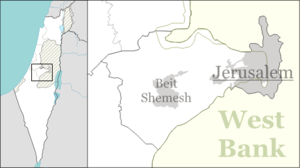Mahseya
Mahseya (Hebrew: מַחְסֵיָה) is a moshav in central Israel. Located about 2 kilometers east of Beit Shemesh, it falls under the jurisdiction of Mateh Yehuda Regional Council. In 2019 it had a population of 477.[1]
Mahseya | |
|---|---|
 Mahseya | |
| Coordinates: 31°44′53.88″N 35°0′23.4″E | |
| Country | Israel |
| District | Jerusalem |
| Council | Mateh Yehuda |
| Affiliation | Hapoel HaMizrachi |
| Founded | 1950 |
| Founded by | Moroccan and Yemenite Jews |
| Population (2019)[1] | 477 |
History
The village was established in 1950 by Jewish immigrants and refugees from Morocco and from Yemen and Aden, on the land of depopulated Palestinian Arab village of Dayr Aban.[2][3] Although it too was later abandoned, it was re-settled by Cochin Jews. Its name is taken from Jeremiah 32:12;
And I delivered the deed of the purchase unto Baruch the son of Neriah, the son of Mahseiah, in the presence of Hanamel mine uncle['s son], and in the presence of the witnesses that subscribed the deed of the purchase, before all the Jews that sat in the court of the guard.[4]
During the 1948 Arab–Israeli War, to the south of the current site of the moshav, there was located a military outpost for the Egyptian army (within the Arab village, Dayr Aban), known as the 'Joint' Command Post, and which place was taken in armed conflict during Operation Ha-Har.
Archaeology
In 2004, archaeologists uncovered a large stone building, 40 × 80 m, with floors composed of chalk, stone and mosaic. An olive press was built to the west. Pottery vessels and coins date the building to the sixth–eighth centuries CE. From the size and nature of construction, it is believed to have been a monastery.[5]
References
- "Population in the Localities 2019" (XLS). Israel Central Bureau of Statistics. Retrieved 16 August 2020.
- Khalidi, Walid (1992). All That Remains: The Palestinian Villages Occupied and Depopulated by Israel in 1948. Washington D.C.: Institute for Palestine Studies. p. 283. ISBN 0-88728-224-5.
- Yalqut Teiman, Yosef Tobi and Shalom Seri (editors), Tel-Aviv 2000, p. 158, s.v. מחסיה (Hebrew) ISBN 965-7121-03-5
- Jeremiah 32:12
- Israel Antiquities Authority, Khirbat es-Suyyagh